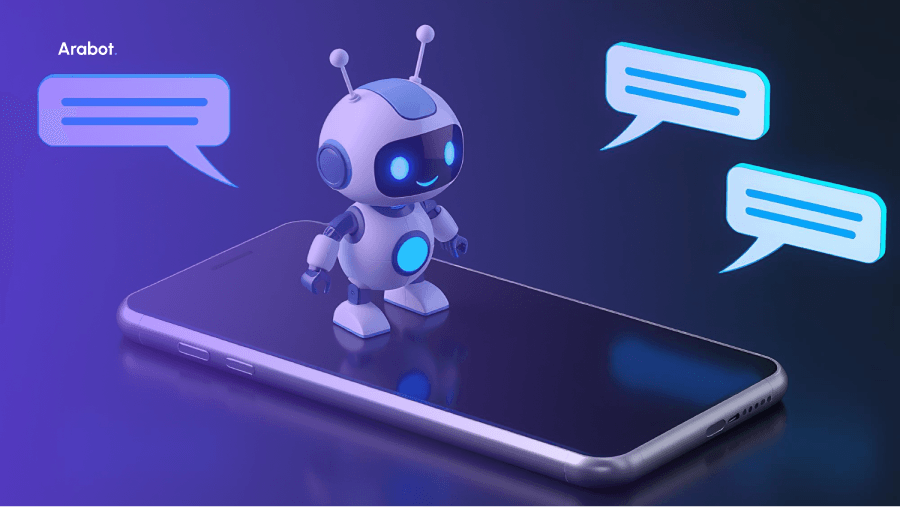Education
Can AI Chatbots Handle Complex Customer Inquiries? What You Need to Know for Your Business

Summary:
• AI chatbots leverage natural language processing (NLP), machine learning (ML), and knowledge base integration to handle complex customer inquiries.
• Key capabilities include natural language understanding, context awareness, information retrieval, continuous learning, multi-step conversations, personalization, and integration with back-end systems.
• Limitations involve ambiguity, lack of emotional intelligence, difficulty with customized solutions, domain-specific knowledge gaps, and dependence on training data quality.
• The future promises further advancements through large language models, transfer learning, multimodal interactions, and continuous data-driven improvement.
• A balanced approach combining AI chatbots and human agents is ideal for delivering exceptional customer experiences while addressing the limitations of chatbots.
• Businesses should explore and implement AI chatbot solutions while recognizing the need for human assistance in certain situations.
In today's fast-paced business landscape, delivering exceptional customer service is paramount. However, as customer inquiries become increasingly complex, businesses are faced with the challenge of providing prompt, accurate, and personalized responses. This is where the power of artificial intelligence (AI) chatbots comes into play. AI chatbots have emerged as a game-changing solution, revolutionizing the way companies approach customer service.
According to a recent study by Gartner, by 2025, AI-powered chatbots will handle a staggering 70% of customer interactions. This statistic highlights the growing importance and adoption of AI chatbots in the customer service realm. Complex customer inquiries can range from intricate product troubleshooting to highly specialized queries that require in-depth knowledge and expertise. Traditional customer service methods may struggle to keep up with the demand for immediate, personalized responses.
AI chatbots, powered by advanced natural language processing (NLP) and machine learning (ML) capabilities, offer a promising solution to address these challenges. These intelligent virtual assistants have the potential to understand complex queries, access vast knowledge bases, and provide tailored responses, all while maintaining a human-like conversational experience. However, as with any emerging technology, there are both advantages and limitations to consider when it comes to AI chatbots handling complex customer inquiries.
In this blog post, we will go into the evolution of AI chatbots, explore their key capabilities and advanced features, and examine the limitations and challenges that still exist. Ultimately, we aim to provide a comprehensive understanding of whether AI chatbots can truly handle complex customer inquiries effectively, and what the future holds for this rapidly evolving technology.
The Evolution of AI Chatbots
The concept of chatbots dates back to the 1960s when Joseph Weizenbaum created ELIZA, one of the earliest conversational programs. ELIZA was designed to mimic a Rogerian psychotherapist, engaging in conversations by recognizing and responding to specific patterns in user input. While groundbreaking for its time, ELIZA's capabilities were limited, and it lacked the ability to truly understand the context and meaning behind the conversations.
Over the following decades, chatbots made incremental progress, but it wasn't until the recent advancements in natural language processing (NLP) and machine learning (ML) that their potential for handling complex customer inquiries truly emerged.
NLP enables chatbots to understand and interpret human language, allowing them to comprehend the context and intent behind user queries. By analyzing the structure, semantics, and pragmatics of language, NLP algorithms can extract relevant information and provide more accurate and contextually appropriate responses.
Machine learning, on the other hand, empowers chatbots to learn and improve over time. By processing large datasets of customer interactions, ML algorithms can identify patterns, learn from previous experiences, and continuously refine their ability to handle complex inquiries more effectively.
The convergence of NLP and ML has given rise to a new generation of conversational AI chatbots that can engage in more natural and intelligent dialogues. These chatbots not only understand the user's query but can also maintain context, ask for clarification, and provide personalized responses based on the user's unique situation.
Furthermore, the integration of chatbots with powerful knowledge bases and back-end systems has enabled them to access vast amounts of information, ranging from product manuals to customer data and order histories. This access to comprehensive knowledge sources has further enhanced their ability to address complex customer inquiries with greater accuracy and depth.
Key Capabilities of AI Chatbots for Complex Inquiries
Natural Language Understanding and Context Awareness
At the core of an AI chatbot's ability to handle complex customer inquiries lies its natural language understanding (NLU) and context awareness capabilities. Through advanced NLP techniques, chatbots can comprehend the nuances of human language, including idioms, slang, and multi-part queries. They can extract relevant entities, interpret the user's intent, and understand the context in which the inquiry is being made.
For example, if a customer asks, "My laptop keeps crashing whenever I try to open a certain program. What should I do?" The chatbot can recognize the entities involved (laptop, program), understand the intent (troubleshooting), and grasp the context (a specific software issue). With this understanding, the chatbot can provide relevant troubleshooting steps or suggest further diagnostic measures tailored to the customer's specific situation.
Knowledge Base Integration and Information Retrieval
To effectively handle complex inquiries, AI chatbots rely on extensive knowledge bases that encompass a wide range of information. These knowledge bases can include product manuals, troubleshooting guides, FAQs, and industry-specific knowledge repositories. By integrating with these knowledge sources, chatbots can access and retrieve relevant information to provide detailed and accurate responses.
For instance, if a customer inquires about a specific product feature or compatibility issue, the chatbot can search through the product manuals and technical specifications to find the most relevant information. It can then synthesize and present the information in a concise and understandable manner, tailored to the customer's query.
Machine Learning and Continuous Improvement
One of the key advantages of AI chatbots is their ability to learn and improve over time through machine learning techniques. As chatbots interact with more customers and handle diverse inquiries, they can analyze the conversations, identify patterns, and refine their understanding of complex queries.
Machine learning algorithms can process feedback, ratings, and conversational data to continuously enhance the chatbot's natural language understanding, response accuracy, and overall effectiveness. This iterative learning process ensures that the chatbot becomes increasingly adept at handling complex inquiries as it gains more experience.
Additionally, chatbots can leverage reinforcement learning techniques, where they receive rewards or penalties based on the quality of their responses. This feedback loop helps the chatbot adjust its behavior and decision-making processes to provide more relevant and satisfactory responses in future interactions.
Advanced Capabilities for Handling Complexity
Multi-Step Interactions and Conversational Flow
Complex customer inquiries often require a series of back-and-forth interactions to gather additional context, clarify details, or troubleshoot issues step-by-step. Advanced AI chatbots are designed to engage in multi-step conversations, maintaining context and coherence throughout the dialogue.
These chatbots can ask follow-up questions, request clarification, or guide the customer through a logical sequence of steps to resolve their inquiry effectively. For example, if a customer reports an issue with a software installation, the chatbot may first inquire about the specific error message or symptoms, then request information about the customer's system configuration, and finally provide tailored troubleshooting steps based on the gathered information.
By managing the conversational flow seamlessly, AI chatbots can handle complex inquiries that require a more intricate problem-solving approach, mimicking the interaction one would have with a knowledgeable human agent.
Personalization and Sentiment Analysis
Customers often seek personalized and empathetic responses, especially when dealing with complex or sensitive inquiries. Advanced AI chatbots leverage sentiment analysis techniques to detect and interpret the customer's emotional state, tone, and intent behind their messages.
By analyzing the sentiment expressed in the customer's inquiry, the chatbot can adapt its language, tone, and approach to provide a more personalized and appropriate response. For instance, if a customer expresses frustration or dissatisfaction, the chatbot can acknowledge their feelings, offer reassurance, and provide a more empathetic response to de-escalate the situation.
Furthermore, chatbots can leverage customer data, preferences, and past interactions to tailor their responses and recommendations, creating a more personalized and relevant experience for each individual customer.
Integration with Back-End Systems and Customer Data
To handle complex inquiries effectively, AI chatbots often need access to customer-specific data, such as order histories, account information, or previous interactions. By integrating with back-end systems and databases, chatbots can retrieve and leverage this valuable information to provide more informed and personalized responses.
For example, if a customer inquires about a past order or subscription, the chatbot can access their account details, retrieve the relevant information, and provide a tailored response specific to their situation. This level of integration allows chatbots to handle complex inquiries that require access to customer-specific data, enhancing the overall customer experience.
Limitations and Challenges
While AI chatbots have made remarkable strides in handling complex customer inquiries, they still face several limitations and challenges that need to be addressed.
Ambiguity and Deep Contextual Understanding
Despite advancements in natural language processing, AI chatbots may still struggle with highly ambiguous queries or those that require a deep contextual understanding beyond their training data or knowledge base. For example, if a customer uses idiomatic expressions, cultural references, or asks a question that requires real-world reasoning, the chatbot may fail to grasp the full context and provide an accurate response.
Emotional Intelligence and Empathy
While AI chatbots can analyze sentiment and adjust their tone accordingly, they may still lack the emotional intelligence and empathy required to handle complex inquiries that involve strong emotions or sensitive topics. Customers dealing with sensitive issues, such as financial hardship or personal matters, may feel the need for genuine human empathy and understanding, which can be challenging for chatbots to replicate effectively.
Customized Solutions and Creative Problem-Solving
AI chatbots excel at providing predefined solutions based on their training data and knowledge bases. However, when it comes to highly unique or unprecedented situations that require creative problem-solving or customized solutions, chatbots may struggle to think outside the box. Human agents, with their ability to think critically and apply innovative approaches, may still be better equipped to handle such complex inquiries.
Domain Expertise and Specialized Knowledge
AI chatbots' performance in handling complex inquiries can be domain-specific. While they may excel in certain domains, such as general customer service or technical support, they may struggle with inquiries that require specialized knowledge or expertise outside their trained area. For instance, a chatbot trained on product support may not be able to handle complex legal or financial inquiries effectively.
Continuous Training and Data Quality
The effectiveness of AI chatbots in handling complex inquiries depends heavily on the quality and diversity of their training data. If the training data is biased, outdated, or lacks sufficient coverage of complex scenarios, the chatbot's performance may be limited. Ensuring a continuous supply of high-quality training data and regular model updates is crucial for maintaining and improving the chatbot's capabilities.
While these limitations and challenges are significant, they do not negate the value and potential of AI chatbots in handling complex customer inquiries. Instead, they highlight the need for a balanced approach, where chatbots and human agents work in tandem to provide a comprehensive and seamless customer experience.
The Future of AI Chatbots for Complex Inquiries
As the field of artificial intelligence continues to evolve at a rapid pace, the future of AI chatbots in handling complex customer inquiries looks extremely promising. Advancements in natural language processing, machine learning, and conversational AI are paving the way for chatbots to become even more sophisticated and capable.
One of the most exciting developments is the integration of large language models (LLMs) and generative AI into chatbot systems. LLMs, like GPT-3 and its successors, have demonstrated remarkable abilities in understanding and generating human-like text, allowing chatbots to engage in more natural and contextually appropriate conversations.
Furthermore, the application of transfer learning techniques could enable chatbots to leverage knowledge from various domains, enhancing their ability to handle specialized inquiries and adapt to new scenarios more efficiently.
As more businesses adopt AI chatbots, the availability of diverse conversational data will increase, providing a valuable resource for continuous learning and improvement. This data-driven approach, combined with advancements in machine learning algorithms, could lead to chatbots that can better understand complex queries, identify patterns, and provide more accurate and personalized responses over time.
Additionally, the integration of multimodal capabilities, such as image and voice recognition, could further enhance the chatbot experience, allowing for more intuitive and seamless interactions across various channels.
However, it is important to note that while AI chatbots are poised to handle increasingly complex inquiries, they are unlikely to completely replace human agents in the foreseeable future. Instead, the future lies in a harmonious collaboration between AI chatbots and human agents, where each plays to their strengths, ensuring a comprehensive and exceptional customer experience.
Businesses that embrace this balanced approach and continually evaluate and adapt their chatbot strategies to meet evolving customer needs and expectations will be well-positioned to stay ahead in the ever-changing landscape of customer service.
In the rapidly evolving world of customer service, AI chatbots have emerged as a game-changing solution, offering the potential to handle complex customer inquiries with unprecedented efficiency and accuracy. Through advanced natural language processing, machine learning, and integration with vast knowledge bases, chatbots can comprehend intricate queries, provide personalized responses, and continuously improve their capabilities.
Learn how arabot can help you set up your conversational AI agent for handling customer inquiries!
© 2025 copyright Arabot. All rights reserved.
 Insurance
Insurance Healthcare
Healthcare Automative
Automative Hospitality
Hospitality Banking
Banking Government
Government Telecommunication
Telecommunication Education
Education Human Resources
Human Resources
